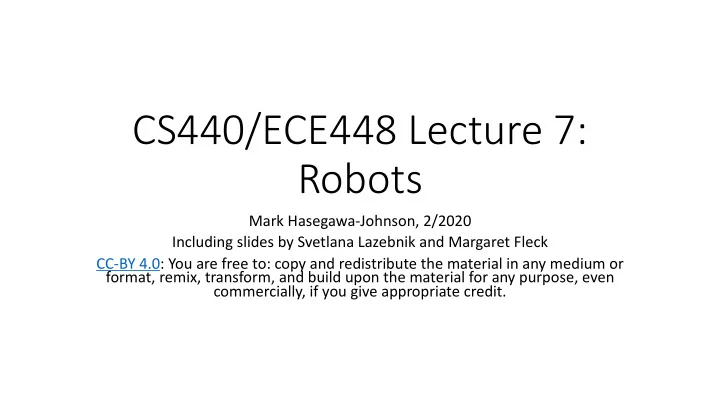

CS440/ECE448 Lecture 7: Robots Mark Hasegawa-Johnson, 2/2020 Including slides by Svetlana Lazebnik and Margaret Fleck CC-BY 4.0: You are free to: copy and redistribute the material in any medium or format, remix, transform, and build upon the material for any purpose, even commercially, if you give appropriate credit.
Agents (textbook chapter 2) • An agent is anything that can be viewed as perceiving its environment through sensors and acting upon that environment through actuators sensations
Example: Vacuum-Agent • Environment = tuple of variables: • Location, status of both rooms, e.g., S = { Loc=A, Status=(Dirty, Dirty) } • Action = variable drawn from a set: A ∈ { Left, Right, Suck, NoOp } • Sensors = tuple of variables: • Location, and status of Current Room Only e.g., S = { Loc=A, Status = Dirty } function Vacuum-Agent ([location,status]) returns an action • if Loc=A • if Status=Dirty then return Suck • else if I have never visited B then return Right • else return NoOp • else • if Status=Dirty then return Suck • else if I have never visited A then return Left • else return NoOp
Specifying the task environment • PEAS: Performance, Environment, Actions, Sensors • P: a function the agent is maximizing (or minimizing) • Assumed given • E: a formal representation for world states • For concreteness, a tuple ( var 1 = val 1 , var 2 = val 2 , … , var n = val n ) • A: actions that change the state according to a transition model • Given a state and action, what is the successor state (or distribution over successor states)? • S: observations that allow the agent to infer the world state • Often come in very different form than the state itself • E.g., in tracking, observations may be pixels and state variables 3D coordinates
What is a “Robot”? A scene from “Rossum’s Universal Robots,” Karel Čapek, 1921 http://www.umich.edu/~engb415/literature/pontee/RUR/RURsmry.html
What is a “Robot”? Example: Shaky the robot, 1972 https://en.wikipedia.org/wiki/Shakey_the_robot PEAS: • Performance • Antenna for radio link • On-board logic • Camera control unit • Environment • Actuators • Caster wheel • Drive motor • Drive wheel • Sensors • Range finder • Television camera • Bump detector
Performance Adeept robot arm for Arduino (from Amazon) • How does the robot arm decide when it has successfully grasped a cup? • How does it find the shortest path for its hand?
The Robot Arm Reaching Problem https://www.mathworks.com/help/fuzzy/modeling-inverse-kinematics-in-a-robotic-arm.html • Our goal is to reach a particular location (x,y) • But we can’t control (x,y) directly! What we actually control is (𝜄 " , 𝜄 # ) .
The Robot Arm Reaching Problem Jeff Ichnowski, University of North Carolina, https://www.cs.unc.edu/~jeffi/c-space/robot.xhtml
The Environment From https://newatlas.com/shakey-robot-sri-fiftieth-anniversary/37668/#gallery
The Environment From https://newatlas.com/shakey-robot-sri-fiftieth-anniversary/37668/#gallery
Properties of Environments (Textbook, Chapter 2) • Fully Observable vs. Partially Observable • Deterministic vs. Stochastic • Episodic vs. Sequential • Static vs. Dynamic • Discrete vs. Continuous • Single agent vs. Multi-agent • Known vs. Unknown
Fully observable vs. partially observable • Do the agent's sensors give it access to the complete state of the environment? • For any given world state, are the values of all the variables known to the agent? vs. Source: L. Zettlemoyer
Deterministic vs. stochastic • Is the next state of the environment completely determined by the current state and the agent’s action ? • Is the transition model deterministic (unique successor state given current state and action) or stochastic (distribution over successor states given current state and action)? • strategic: the environment is deterministic except for the actions of other agents vs.
Episodic vs. sequential • Is the agent’s experience divided into unconnected episodes, or is it a coherent sequence of observations and actions? • Does each problem instance involve just one action or a series of actions that change the world state according to the transition model? vs.
Static vs. dynamic • Is the world changing while the agent is thinking? Semidynamic: the environment does not change with the passage of time, but the agent's • performance score does vs.
Discrete vs. continuous • Does the environment provide a countable (discrete) or uncountably infinite (continuous) number of distinct percepts, actions, and environment states? • Are the values of the state variables discrete or continuous? • Time can also evolve in a discrete or continuous fashion • “Distinct” = different values of utility vs.
Single-agent vs. multiagent • Is an agent operating by itself in the environment? vs.
Known vs. unknown • Are the rules of the environment (transition model and rewards associated with states) known to the agent? • Strictly speaking, not a property of the environment, but of the agent’s state of knowledge vs.
Types of Environments Shakey’s environment is: • Partially observable (not Fully) • Deterministic (not Stochastic) • Sequential (not Episodic) • Static (not Dynamic) • Continuous (not Discrete) • Single-agent (not Multi-agent) • Known (not Unknown)
Types of Environments Shakey’s environment is: • Partially observable • Deterministic • Sequential • Static Dynamic? • Continuous • Single-agent • Known
Types of Environments Jeff Ichnowski’s environment is: • Partially Fully observable • Deterministic • Sequential • Static • Continuous • Single-agent • Known
Types of Environments Euronews, https://www.youtube.com/watch?v=b5DEg2qZzkU The drone’s environment is: • Partially observable • Deterministic • Sequential • Static Dynamic? • Continuous • Single Multi-agent • Known (?)
Conclusions • A robot, like any other agent, is characterized by its PEAS: • Performance • Environment • Actions • Sensors • Environments are characterized as: • Fully Observable vs. Partially Observable • Deterministic vs. Stochastic • Episodic vs. Sequential • Static vs. Dynamic • Discrete vs. Continuous • Single agent vs. Multi-agent • Known vs. Unknown
Recommend
More recommend